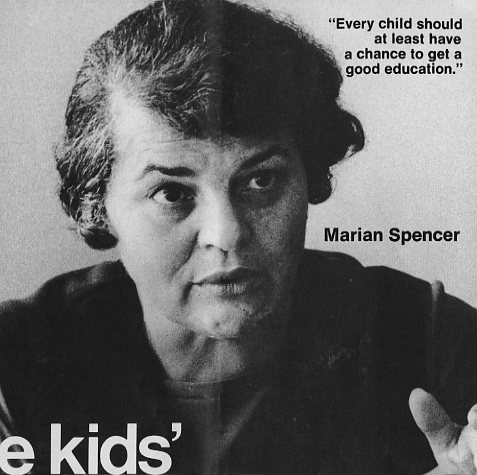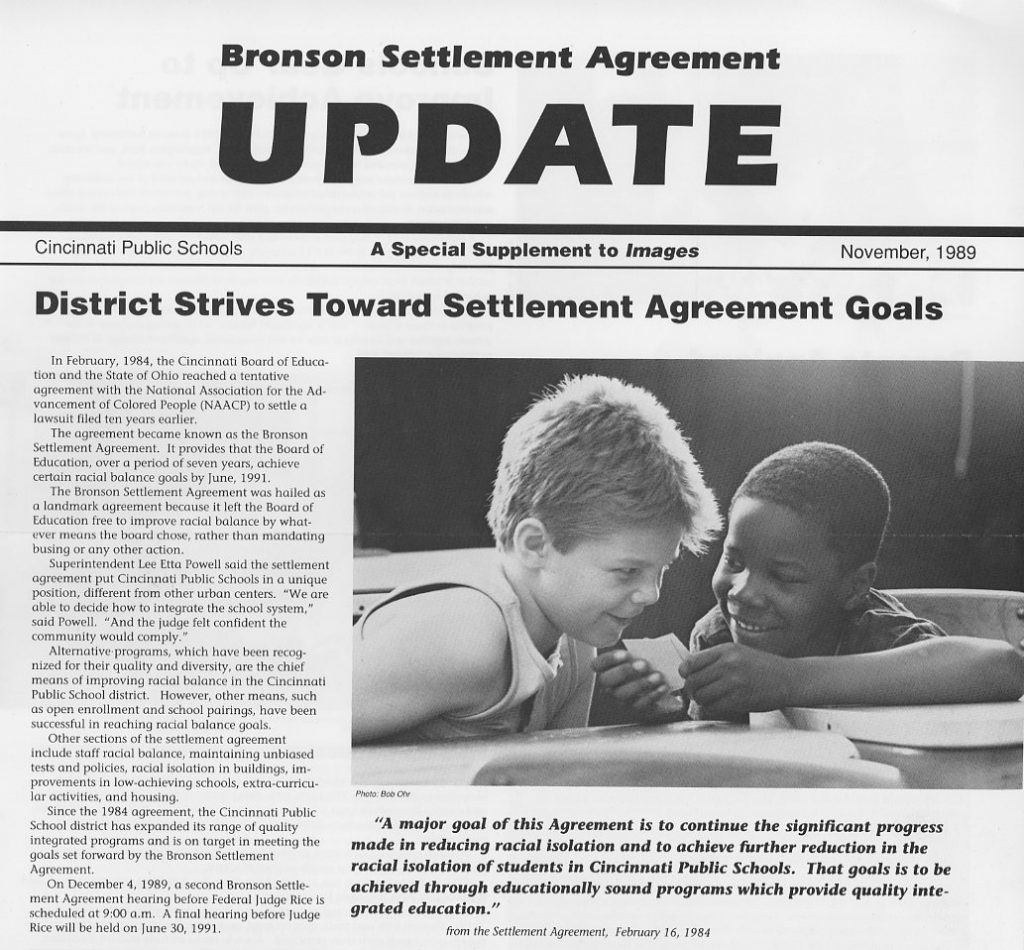The State of Ohio repealed its so called “Black Codes” mandating legal segregation in 1887. However, de facto segregation remained common throughout the State and still persists in many of Ohio’s cities today. Racial isolation in education often results from economic segregation of African Americans in low income neighborhoods or “white flight” to suburban areas. Other times, school districts consciously and sinisterly draw arbitrary lines between white and black neighborhoods in an effort to intentionally separate the races. Cincinnati struggled with racial isolation and segregation in its city school district well into the twentieth century. In 1977, eighty percent of Cincinnati’s schools failed to meet the integration goals laid out by the United States Civil Rights Commission.
Marian Spencer decided that she needed to take action and help lead the effort to achieve educational equity in Cincinnati. Spencer would work for decades, beginning in the early 1970s, to integrate Cincinnati schools, reduce racial isolation, and foster diversity and inclusion in the Queen City. In 1973, Spencer ran for a seat on the Board of Education of Cincinnati. Though unsuccessful in her campaign, she made important contacts in education, formulate d her ideas and goals for the city, and strongly advocated for a more equitable school system. Marian then became the Chairperson of the Education Committee for the Cincinnati NAACP in 1974, a position that she would hold for twenty years. The NAACP of Cincinnati had already been fighting for school desegregation efforts in Cincinnati for decades, filing lawsuits on behalf of pupils in segregated schools, advocating on behalf of black teachers for fairness in hiring practices and treatment once employed, and listening to the complaints of parents and students regarding punishments or conditions in the schools. Marian continued these practices, proving herself a strong advocate for the African American community when it came to a variety of educational matters. She often spoke at local events during this time. For example, in 1978 she gave a speech titled “Desegregation in the Schools” at the Presbyterian Church in the neighborhood of Wyoming.
d her ideas and goals for the city, and strongly advocated for a more equitable school system. Marian then became the Chairperson of the Education Committee for the Cincinnati NAACP in 1974, a position that she would hold for twenty years. The NAACP of Cincinnati had already been fighting for school desegregation efforts in Cincinnati for decades, filing lawsuits on behalf of pupils in segregated schools, advocating on behalf of black teachers for fairness in hiring practices and treatment once employed, and listening to the complaints of parents and students regarding punishments or conditions in the schools. Marian continued these practices, proving herself a strong advocate for the African American community when it came to a variety of educational matters. She often spoke at local events during this time. For example, in 1978 she gave a speech titled “Desegregation in the Schools” at the Presbyterian Church in the neighborhood of Wyoming.
Spencer undertook the most important case in the fight for school desegregation in Cincinnati: Mona Bronson et al. v. Board of Education of the City School District of the City of Cincinnati in 1974 as NAACP Education Committee Chairperson. Later known as simply the Bronson case, Spencer and the NAACP organized the plantiffs and brought suit against the school board on their behalf. The position of the NAACP was that Cincinnati Public Schools operated as racially segregated institutions in violation of the fourteenth amendment of the United States. In 1983 and into 1984, Judge David Porter of the U.S. District Court of Southern Ohio and Warner Patterson of the Department of Justice helped the plantiffs and Cincinnati School Board come to an agreement. The parties agreed to specific goals in lowering the “Taeuber Index,” a number that measures racial isolation within schools. The district would primarily achieve its goals through alternative school programs. The alternative programs sought to provide students with specialized training and experiences, such as fine arts or technology, that would attract a diverse pool of students voluntarily and facilitate racial mixing. Further, it was agreed that, if the alternative programs failed to sufficiently desegregate schools, the court could order more forceful methods such as increased busing or the redrawing of districts in seven years.
In order to implement and pro mote the Bronson case settlement agreement, the Board of Education formed a Community Wide Task Force in 1986. The task force consisted of members appointed by the Board and by community organizations, and the NAACP of Cincinnati decided to appoint Marian Spencer to the task force. The Community Wide Task Force sought to “improve the racial balance in schools in the Cincinnati district” and “secure the widest possible support throughout the community for fair and effective performance” of the settlement. The task force recommended many alternative programs and promoted diverse enrollment in these specialized courses as a primary means to decrease segregation in the city. For example, Hughes High School in the Clifton neighborhood was recommended to become math and science focused while Woodward High School was to focus on business training. Further, they recommended “pairing” or “clustering” African American schools that were racially isolated with nearby white schools that were similarly isolated. For example, Bloom and Roberts Middle School could be paired and clustered together into two more integrated middle schools.
mote the Bronson case settlement agreement, the Board of Education formed a Community Wide Task Force in 1986. The task force consisted of members appointed by the Board and by community organizations, and the NAACP of Cincinnati decided to appoint Marian Spencer to the task force. The Community Wide Task Force sought to “improve the racial balance in schools in the Cincinnati district” and “secure the widest possible support throughout the community for fair and effective performance” of the settlement. The task force recommended many alternative programs and promoted diverse enrollment in these specialized courses as a primary means to decrease segregation in the city. For example, Hughes High School in the Clifton neighborhood was recommended to become math and science focused while Woodward High School was to focus on business training. Further, they recommended “pairing” or “clustering” African American schools that were racially isolated with nearby white schools that were similarly isolated. For example, Bloom and Roberts Middle School could be paired and clustered together into two more integrated middle schools.
Though the sailing was not always smooth and some alternative programs worked better than others, the Community Wide Task Force and the Cincinnati Board of Education saw success in their efforts to reduce racial isolation and segregation in Cincinnati schools. By 1990, a year before the court agreement goals needed to be met, Cincinnati middle schools had well surpassed their integration benchmark of 34.2 (Taueber Index) with a score of 32.6. Additionally, elementary schools had drawn within a half point of their goal with a year to go. The dedication of Marian Spencer, the NAACP, and the Community Wide Task Force helped to make integration a priority in Cincinnati Schools through their diligent efforts.